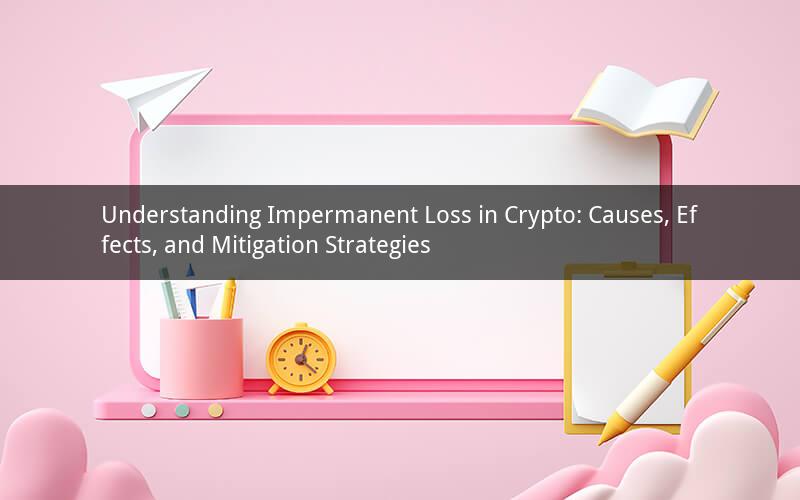
Impermanent loss is a term commonly associated with decentralized finance (DeFi) and crypto trading. It refers to the potential loss incurred when a trader holds a position in a liquidity pool or trades a cryptocurrency. In this article, we will delve into the causes, effects, and mitigation strategies of impermanent loss in crypto.
What is Impermanent Loss?
Impermanent loss occurs when the price of a cryptocurrency in a liquidity pool or a trading position changes while the trader holds it. This loss arises from the difference between the current price of the cryptocurrency and the price at which it was initially acquired. The loss is impermanent because it can be reversed if the price of the cryptocurrency returns to its original value or increases further.
Causes of Impermanent Loss
1. Price Fluctuations: The primary cause of impermanent loss is the volatility of cryptocurrencies. As prices fluctuate, the value of the cryptocurrency in a liquidity pool or a trading position changes accordingly.
2. Market Trends: Market trends can significantly impact the value of a cryptocurrency. For instance, if the market trends downwards, the price of the cryptocurrency will likely decrease, leading to an impermanent loss.
3. Inactivity: Holding a cryptocurrency for an extended period can lead to impermanent loss. As the market evolves, the value of the cryptocurrency can change, resulting in a loss for the trader.
Effects of Impermanent Loss
1. Financial Loss: The most apparent effect of impermanent loss is the financial loss incurred by the trader. This loss can be significant, depending on the size of the position and the degree of price volatility.
2. Psychological Impact: Dealing with impermanent loss can be emotionally challenging. Traders may experience frustration, anxiety, and a loss of confidence in their trading abilities.
3. Long-term Implications: Impermanent loss can affect the long-term profitability of a trader. If a trader consistently incurs impermanent loss, it may erode their capital and prevent them from achieving their investment goals.
Mitigation Strategies
1. Diversification: Diversifying your portfolio can help mitigate the impact of impermanent loss. By holding a variety of cryptocurrencies, you can reduce the risk of being significantly affected by price fluctuations in a single asset.
2. Staking: Staking is a process where you lock your cryptocurrency in a wallet to support the network and earn rewards. Staking can help offset the impact of impermanent loss, as you are receiving rewards in the form of additional cryptocurrency.
3. Stop-Loss Orders: Implementing stop-loss orders can help protect your portfolio from significant losses. A stop-loss order is an instruction to sell a cryptocurrency when its price reaches a specified level.
4. Leveraging Yield Farming: Yield farming involves lending your cryptocurrency to a DeFi platform in exchange for interest payments. This strategy can help offset the impact of impermanent loss by generating additional income.
5. Risk Management: Implementing sound risk management practices, such as setting a budget and diversifying your investments, can help mitigate the impact of impermanent loss.
Frequently Asked Questions
1. How can I calculate the impermanent loss on my position?
You can calculate the impermanent loss by using the following formula: Impermanent Loss = (Current Price - Original Price) Amount Held. This formula assumes a linear relationship between price and impermanent loss, which may not always be accurate.
2. Can impermanent loss be avoided?
Impermanent loss cannot be entirely avoided, as it is an inherent risk associated with cryptocurrency trading and DeFi platforms. However, by implementing the strategies mentioned above, you can minimize its impact.
3. What is the difference between permanent and impermanent loss?
Permanent loss occurs when a cryptocurrency is lost forever, such as through theft or loss of private keys. In contrast, impermanent loss is a temporary loss that can be reversed if the price of the cryptocurrency returns to its original value or increases.
4. Can I earn a profit despite impermanent loss?
Yes, you can still earn a profit despite incurring impermanent loss. If the price of the cryptocurrency increases sufficiently, the profit from the price appreciation may outweigh the loss incurred due to impermanent loss.
5. How can I improve my trading strategy to minimize impermanent loss?
To minimize impermanent loss, consider diversifying your portfolio, using stop-loss orders, staking your cryptocurrency, and leveraging yield farming. Additionally, staying informed about market trends and adjusting your strategy accordingly can help reduce the impact of impermanent loss.